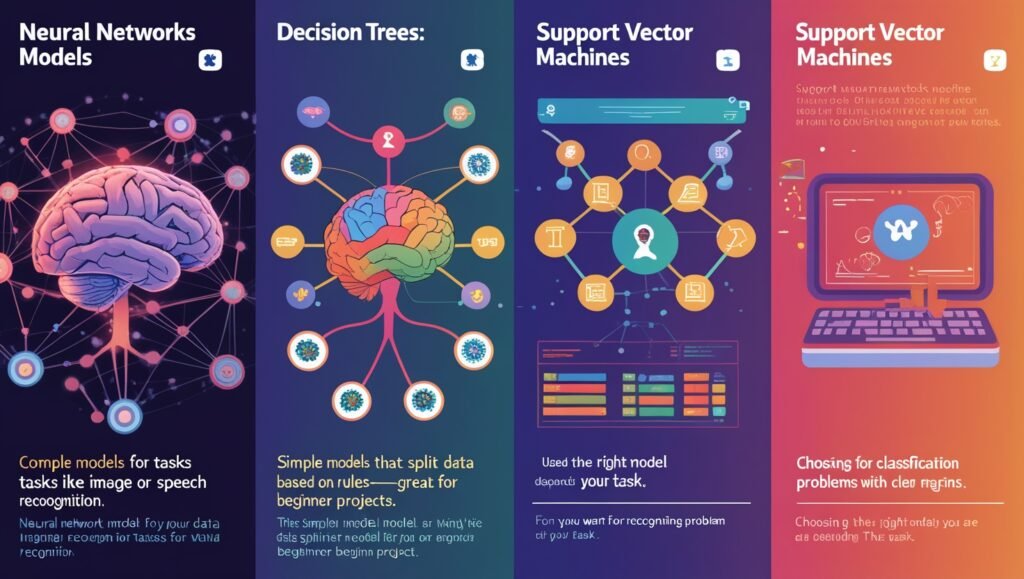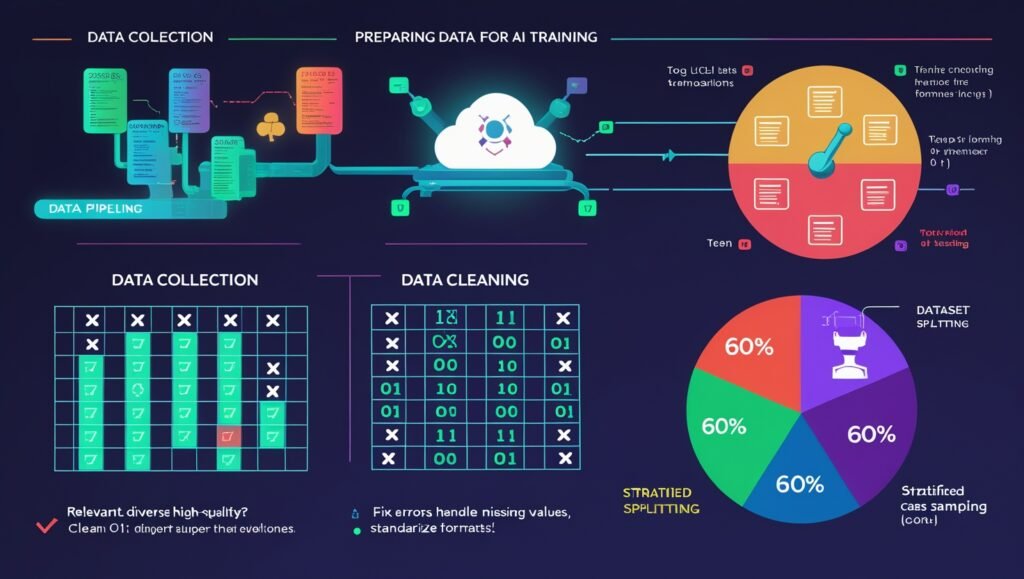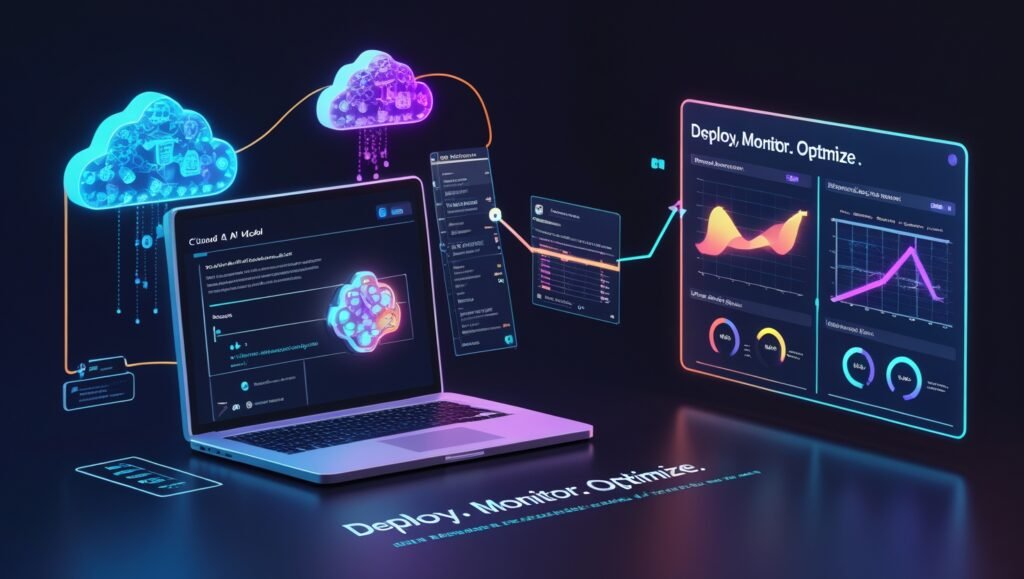
Introduction
Artificial intelligence is changing how we do things every day. From recommending movies on Netflix to helping doctors spot diseases, AI is everywhere. Learning how to train your first AI model opens doors to many new opportunities. Thanks to easier-to-use AI tools, even beginners can dip their toes into this exciting field. This guide will walk you through each step to create your first AI model—from understanding the basics to deploying your project successfully. Ready to turn data into smart solutions? Let’s start.
Understanding the Basics of AI and Machine Learning
What is Artificial Intelligence and Machine Learning?
Artificial intelligence (AI) means making computers do tasks that typically need human thinking. Machine learning (ML) is a way to train these computers to learn from data. Think of AI as the overall goal, like creating smart robots, and ML as the method to get there by teaching computers using examples.
Real-world uses include voice assistants like Siri, image recognition in photo apps, and personalized shopping recommendations. They all rely on AI and ML working together.
Key Concepts and Terminology
- Supervised learning: Teaching the AI with labeled data—like pictures with tags.
- Unsupervised learning: Giving unlabeled data to find patterns—like grouping customer types.
- Reinforcement learning: Training through trial and error, like teaching a robot to walk.
Other important ideas are:
- Overfitting: The model learns the training data too well and fails on new data.
- Underfitting: The model isn’t learning enough and performs poorly overall.
- Datasets: Collections of data split into training, validation, and testing parts to help train and evaluate your model effectively.
The quality of your data and accurate labels are key to making your model perform well.
Common Types of AI Models

- Neural networks: Complex models for tasks like image or speech recognition.
- Decision trees: Simple models that split data based on rules—great for beginner projects.
- Support vector machines: Used for classification problems with clear margins.
Choosing the right model depends on your task. For example, if you want to recognize images, a neural network like CNNs (convolutional neural networks) is best.
Preparing Your Data for Training

Data Collection
Start by gathering data from reliable sources. Public datasets, web scraping, and APIs are common options. Make sure your data is relevant for your goal and includes enough variety to teach the model well.
Data Cleaning and Preprocessing
Raw data is often messy. Remove duplicates, fix errors, and deal with missing info. Convert data into formats your models can understand. For example, normalize numbers and encode categories as numbers or labels.
Dataset Splitting
Divide your data into three parts:
- Training set: For teaching the model.
- Validation set: To tune settings during training.
- Testing set: To see how well your model performs on new data.
Use stratified sampling to keep data balanced across groups, so your model doesn’t get biased.
Choosing the Right Tools and Frameworks
Popular AI Frameworks and Libraries
- TensorFlow: Great for deep learning projects.
- PyTorch: Popular for research and flexibility.
- Scikit-learn: Perfect for beginner projects and classic algorithms.
- Keras: Easy-to-use API built on TensorFlow.
Pick a tool based on your project size, complexity, and your familiarity with coding.
Setting Up Your Environment
Install Python, set up virtual environments to keep dependencies tidy. Many beginners use cloud platforms like Google Colab which offer free access to powerful hardware. These make it easier to experiment without setting up complex software.
Managing Data Pipelines
Load your datasets into frameworks smoothly. Use data pipelines to process big data efficiently, avoiding delays during training.
Designing and Training Your AI Model
Selecting the Model Architecture
For beginners, start with simple models like linear regression or a basic neural network. Choose your architecture based on your task: classification, regression, or clustering.
Hyperparameter Tuning
Adjust key settings, called hyperparameters, such as:
- Learning rate
- Number of epochs (passes through data)
- Batch size
You can use grid search or random search to find the best combo. But start with default settings and tweak after observing results.
Training the Model
Run your training loop, watching how the model improves. Keep track of performance using accuracy, loss, or other metrics. If your model overfits, stop early or add regularization. Never forget to validate your model during training to avoid issues.
Evaluating and Improving Your Model
Model Evaluation
Use tools like confusion matrices and ROC curves to see how your model is doing. Metrics like F1 score help measure precision versus recall, especially in unbalanced classes.
Troubleshooting Common Issues
- Overfitting: Your model performs too well on training but poorly on new data. Fix with regularization or more data.
- Underfitting: Your model isn’t capturing enough patterns. Try a more complex model.
- Noisy data: Bad data can ruin performance. Clean and preprocess your data carefully.
Refining the Model
Adjust hyperparameters, try different model architectures, or add new features. For more complex tasks, transfer learning allows you to use pre-trained models and improve your results faster.
Deploying and Monitoring Your AI Model

Deployment Options
Make your model accessible via cloud services or as an API. Use tools like Flask or FastAPI to create simple web interfaces. Cloud options like AWS, Google Cloud, or Azure simplify the deployment process.
Monitoring Performance
Track how your AI performs once live. Keep an eye on accuracy, and watch for model drift, meaning the model gets less accurate as data changes. Regular retraining with new data helps keep your model sharp.
Best Practices
Update your model frequently, test with fresh data, and watch out for bias. Ethical use and fairness should always be a top priority.
Conclusion
Training an AI model involves many important steps. You start by understanding the core concepts, then gather and prepare your data. Next, pick the right tools and design your model. Train, evaluate, and improve it step by step. Finally, deploy your AI and keep monitoring its performance over time.
Remember, building an AI model isn’t a one-time task. It’s an ongoing process of learning, adjusting, and experimenting. Keep exploring new ideas and techniques to stay ahead. With patience and practice, you’ll turn raw data into powerful AI solutions that can make a real difference. Ready to get started? Your AI journey begins now.